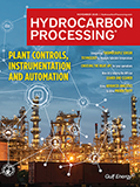November 2019
Hydrocarbon Processing Awards
Hydrocarbon Processing Awards Winners
Hydrocarbon Processing, the downstream processing sector’s leading technical publication, has announced the winners for its third annual awards. The HP Awards celebrate innovative technologies and people that have been instrumental in improving facility operations over the past year.
This is a preview of our premium content. Thank you for your interest—please log in or subscribe to read the full article.






Comments